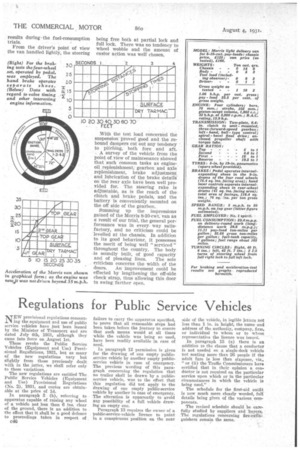Regulations for Public Service Vehicles
Page 68

If you've noticed an error in this article please click here to report it so we can fix it.
10‘TEW provisional regulations concern ing the equipment and use of public service vehicles have just been issued by the Minister of Transport and are dated July 4th, 1931, although they came into force on August 1st.
These revoke the Public Service Vehicles (Equipment and Use) Provisional Regulations, 1931, but as many of the new regulations vary but slightly from those previously dealt with in the latter, we shall refer only to these variations.
The new regulations are entitled The Public Service Vehicles (Equipment and Use) Provisional Regulations (No. 2), 1931, and conies are obtainable at the price of 1.d.
In paragraph 3 (b), referring to apparatus capable of raising any wheel of a vehicle not less than 6 ins, clear of the ground, there is an addition to the effect that it shall he a good defence to proceedings taken in respect of
C46
failure to carry the apparatus specified, to prove that all reasonable steps had been taken before the journey to ensure that such means would at all times while the vehicle was being so used, have been readily available in case of need.
In paragraph 12 permission is given for the drawing of one empty publicservice vehicle by another empty publicservice vehicle in case of emergency. The previous wording of this paragraph concerning the regulation that no trailer shall be drawn by a publicservice vehicle, was to the effect that this regulation did not apply to the drawing of one empty public-service vehicle by another in case of emergency. The alteration is apparently to avoid any possibility of a full vehicle drawing an empty one.
Paragraph 13 requires the owner of a public-service-vehicle licence to paint in a conspicuous position on the near
side of the vehicle, in legible Jetters not less than 1 in. in height, the name and address of the authority, coMpany, firm, or individual to whom or to whose
representative the licence was issued.
In Paragraph 15 (a) there is an addition to the clause that a conductor is not needed. on a single-deck vehicle not seating more than 26 people if the adult fare is less than sixpence, viz., "or (ii) the Traffic Commissioners have certified that in their opinion a conductor is not reouired on the particular service unon which or in the particular circumstances in which the vehicle is being used."
The schedule for the first-aid outfit is now much more clearly worded, full details being given of the various, components.
The revised schedule should be caPefully studied by suppliers and buyers. The regulations concerning fire-extinguishers remain the same.












































































































